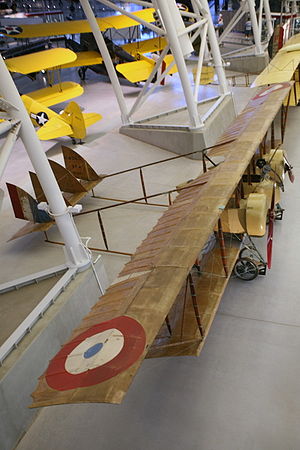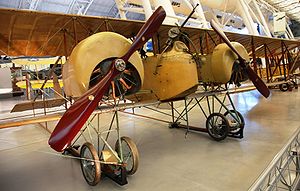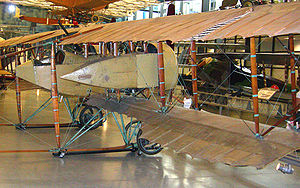Caudron G.4 Video - National Air and Space Museum's Caudron G4
|
|
Caudron G.4
G.4

Picture - Caudron G-4 - Smithsonian
Role: Bomber
Manufacturer: Caudron
Designed by: Caudron Frx¨res
First flight: 1915
Primary users: French Air Force
Italian Air Force
RNAS
Finnish Air Force
Number built: 1,421
Developed from: Caudron G.3

Picture - Caudron G.4 in Steven F. Udvar-Hazy Center
The Caudron G.4 was a French biplane with twin engines, widely used during World War I as a bomber aircraft. It was designed by René and Gaston Caudron as an improvement over their Caudron G.3. The aircraft was no delight for the eye with its massive, open construction. The aircraft employed wing warping for banking. The first G.4 was manufactured in 1915, both in France, England and in Italy.
The Caudron G.4 was used as a reconnaissance bomber into the heart of Germany. Later, when Germany developed a fighter force, the aircraft had to be used for night bombings.
The G.4 was in use in Belgium, France, Finland, Italy, UK, and in the United States.
Development

Picture - Side view of Caudron G.4 in Steven F. Udvar-Hazy Center.
While the Caudron G.3 was a reliable reconnaissance aircraft, it could not carry a useful bombload, and owing to its design, was difficult to fit with useful defensive armament. In order to solve these problems, the Caudron G4 was designed as a twin engined development of the G.3, first flying in March 1915. While the G.4 had a similar pod and boom layout to the G.3, it has two Le Rhx´ne rotary or Anzani 10 radial engines mounted on struts between the wings instead of a single similar engine at the front of the crew nacelle, while wingspan was increased and the tailplane had four rudders instead of two. This allowed an observer/gunner position to be fitted in the nose of the nacelle, while the additional power allowed it to carry a bombload of 100 kg.
A total of 1358 G.4s were produced in France, while a further 51 examples produced by the A.E.R. company in Italy and 12 were built in Britain by the British Caudron company.
Operational history
World War 1
The G.4 entered service with the French Aéronautique Militaire in November 1915. It was the first twin engined aircraft in service in any numbers with the French. The Caudron G.4 was used to carry out bombing raids deep behind the front line, being used to attack targets as far away as the Rhineland. Increasing losses led to its withdrawal from day bombing missions by the French in the autumn of 1916.
The British Royal Naval Air Service (RNAS) also used the G.4 as a bomber, receiving 55, of which twelve were licence built by the British Caudron company and the remainder supplied from France. Number 4 and 5 Wing RNAS using the G.4 for attacks against German seaplane and airship bases in Belgium. It was finally replaced in RNAS service by Handley Page O/100 aircraft in the autumn of 1917. Italian G.4s proved successful in operating in the mountainous Alpine fronts, where its good altitude capabilities proved useful. The G.4 was also used by the Imperial Russian Air Force for reconnaissance purposes.
Use in Finland
The Finnish Air Force purchased one G.4 as well as two G.3s aircraft with spares, from Flyg Aktiebolaget on April 26, 1923 for 100,000 Finnish markka. The G.4 was used by the FAF as an ambulance aircraft in 1923.
Variants
The first G.4 prototype flew in March 1915. The G.4 was manufactured in three main versions, A2 for reconnaissance, B2 for bombing and E2 for training. The A2 was equipped with a radio for fire spotting, B2 could carry 100 kg of bombs and the E2 was equipped with dual controls. G.4IB (French: Blindage) was an armoured version. There were also other bomber and escort aircraft versions.
The G.6 was a further developed G.4, with a conventional fuselage and tail replacing the pod and boom arrangement of the G.3.
Specifications (G.4)
Data from Suomen ilmavoimien lentokoneet
General characteristics
Crew: Two, pilot and observer/gunner
Length: 7.27 m (23 ft 10 in)
Wingspan: 17.20 m (56 ft 5 in)
Height: 2.60 m (8 ft 6 in)
Wing area: 38.00 m² (409 ft²)
Empty weight: 733 kg (1,612 lb)
Max takeoff weight: 1,180 kg (2,600 lb)
Powerplant: 2x— Le Rhx´ne C radial, 60 kW (80 hp) each
Performance
Maximum speed: 124 km/h (67 knots, 77 mph)
Service ceiling: 4,000 m (13,100 ft)
Endurance: 3½ hours
Armament
1 x— machine gun
113 kg (250 lb) of bombs
Donald, David (Editor). The Encyclopedia of World Aircraft. Leicester, UK: Blitz Editions, 1997. ISBN 1-85605-375-X.
Kalevi Keskinen, Kyx¶sti Partonen, Kari Stenman: Suomen Ilmavoimat I 1918-27, 2005. ISBN 952-99432-2-9.
Kalevi Keskinen, Kari Stenman, Klaus Niska: Suomen ilmavoimien lentokoneet 1918-1939', Tietoteos, 1976.
Thetford, Owen. British Naval Aircraft since 1912. London:Putnam, 1978. ISBN 0 370 30021 1.
Caudron G.4 Pictures and Caudron G.4 for Sale.
Living Warbirds: The best warbirds DVD series.
Source: WikiPedia